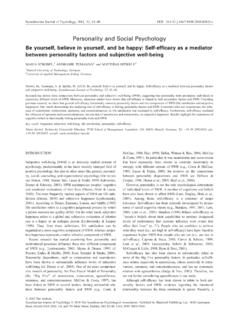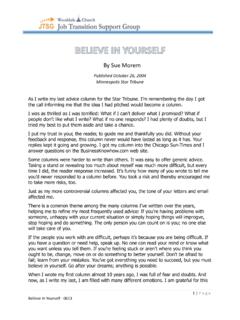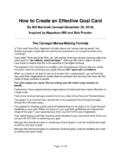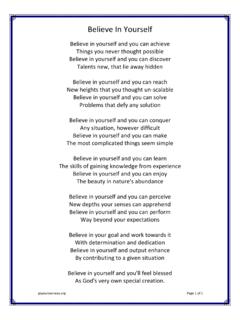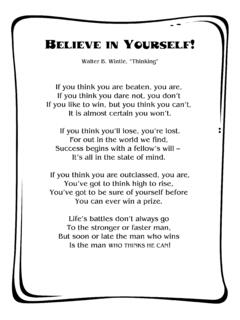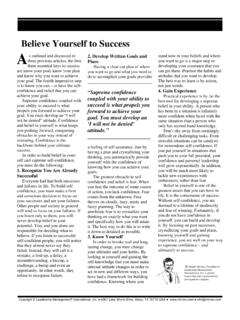Transcription of Believe in yourself. You must do that which you think you ...
1 CHEMISTRY 101 Name _____ Hour Exam II October 28, 2014 Signature _____ Adams/Esbenshade Section _____ " Believe in yourself . You must do that which you think you cannot." --Eleanor Roosevelt-- This exam contains 17 questions on 7 numbered pages. Check now to make sure you have a complete exam. You have one hour and thirty minutes to complete the exam. Determine the best answer to the first 15 questions and enter these on the special answer sheet.
2 Also, circle your responses in this exam booklet. Show all of your work and provide complete answers to questions 16 and 17. 1-15 (30 pts.) _____ 16 (14 pts.) _____ 17 (16 pts.) _____ Total (60 pts) _____ Useful Information: 1 L = 1000 mL (exactly) Always assume ideal behavior for gases (unless explicitly told otherwise). PV = nRT R = L atm/mol K K = C + 273 NA = 1023 Solubility Rules: 1. Most nitrate salts are soluble. 2. Most salts of sodium, potassium, and ammonium cations are soluble. 3. Most chloride salts are soluble.
3 Exceptions: silver(I), lead(II), and mercury(I) chloride. 4. Most sulfate salts are soluble. Exceptions: calcium, barium, and lead(II) sulfate. 5. Most hydroxide salts can be considered insoluble. Soluble ones: sodium, potassium, ammonium, and calcium hydroxide. 6. Consider sulfide, carbonate, and phosphate salts to be insoluble. Soluble ones: sodium, potassium, and ammonium. CHEMISTRY 101 Fall 2014 Hour Exam II Page No. 1 1. The limiting reactant is the reactant (choose the best answer): a) that is present as the smallest mass in grams.
4 B) that has the smallest coefficient in the balanced equation. c) that is left over after the reaction has gone to completion. d) that has the smallest molar mass. e) none of the above 2. which of the following statements is false for the reaction of hydrogen gas with oxygen gas to produce water? (a, b, and c represent the respective coefficients) a) Subscripts can also be used to balance this equation, just as they can be used to balance the charges in an ionic compound (metal with nonmetal). b) The sum of a + b + c equals 5 when balanced in standard form.
5 C) Coefficient b can equal because coefficients can be fractions. d) The number of atoms on the reactant side must equal the number of atoms on the product side. e) The ratio of a/c must always equal one. ---------------------------------------- ---------------------------------------- ---------------------------- Consider the following scenario to answer questions 3 and 4: Boron nitride reacts with iodine monofluoride in trichlorofluoromethane at 30 C to produce pure nitrogen triiodide and byproduct (BF3). See the balanced equation below.
6 BN + 3IF NI3 + BF3 3. What mass of iodine monofluoride must be used to produce g of nitrogen triiodide? a) g b) g c) g d) g e) g 4. When g of nitrogen triiodide is produced, what is the maximum mass of byproduct (BF3) created? a) g b) g c) g d) g e) g ---------------------------------------- ---------------------------------------- ---------------------------- 5. You add mL of water to mL of a M calcium chloride solution. How many moles of calcium chloride are in the new solution? a) mol b) mol c) mol d) mol e) mol 6.
7 Crude gunpowders often contain a mixture of potassium nitrate and charcoal (carbon). When such a mixture is heated until reaction occurs, a solid residue of potassium carbonate is produced. The explosive force of the gunpowder comes from the fact that two gases are also produced (carbon monoxide and nitrogen), which increase in volume with great force and speed. Write the balanced chemical equation for this process and determine the sum of the coefficients. a) 3 b) 5 c) 8 d) 10 e) 11 CHEMISTRY 101 Fall 2014 Hour Exam II Page No.
8 2 7. What volume of a M NaOH solution would be required to neutralize (exactly react with) mL of a M H2SO4 solution? a) mL b) mL c) mL d) mL e) mL ---------------------------------------- ---------------------------------------- ---------------------------- Consider the following unbalanced chemical equation: Al4C3 + H2O Al(OH)3 + CH4 Balance the equation above and then answer questions 8 and 9. 8. If moles of Al4C3 react with moles of H2O, how many moles of Al(OH)3 would be produced after the reaction is complete?
9 A) mol b) mol c) mol d) mol e) 130. mol 9. Determine the mole(s) of reactant leftover. a) mol b) mol c) mol d) mol e) mol ---------------------------------------- ---------------------------------------- ---------------------------- 10. which of the following solutions contains the greatest number of ions? a) mL of M sodium nitrate b) mL of M iron(III) nitrate c) mL of M copper(II) nitrate d) mL of M calcium nitrate e) All of the solutions above (a d) contain the same number of ions. 11.
10 Consider the following unbalanced chemical equation in which element X is unknown. X(s) + F2(g) XF3(s) If g of element X(s) is completely reacted with L of fluorine gas at 250. C and atm, what is the identity of X? a) K b) Co c) Al d) Si e) H2 CHEMISTRY 101 Fall 2014 Hour Exam II Page No. 3 ---------------------------------------- ---------------------------------------- ---------------------------- For questions 12 and 13, consider the reaction between L of M magnesium nitrate and L of M potassium hydroxide.
